Free Program - VBT for Powerlifting Version 2.0 (RepOne One Academy)
Our best velocity based training program yet
No, ChatGPT did not write this article.
Another January has come around, you're a year older, and you still haven't made fitness a priority in your life. You know you should - walking up stairs isn't getting any easier and even Milo of Croton couldn't keep up with your growing Niece. But exercise is complicated, trainers are expensive, and you know a month of getting nowhere on your own would just be a demotivating waste of time. A thought crosses your mind - if ChatGPT can write you a Shakespearean play about deadly bowel movements (you know you've tried it), maybe it can write you a workout plan? You rush to the computer, only to realize the quality of the output is directly correlated to the quality of your inputs, and again, you're back at square one.
I'm here to help. I've been a trainer and competitive powerlifter for 15 years, and I can show you how to replace me with a Large Language Model, the limitations that come with it, and why you should think twice before hiring your new AI personal trainer.
Prompt #1: Build me a program.
You should have some idea of what you want to do. The more specific you can get, the better, as LLM's like ChatGPT love to give down-the-middle answers that often leave a lot to be desired. In this example I'll ask it to write a program that most closely mimics what I'd write for clients, so I can evaluate the output. I'll ask it to write me a DUP program, a periodization style that effectively balances training load and recovery that maximizes gains, and I'll include my schedule, and what I'm particularly interested in improving in the short term.
Build a daily undulating periodization based powerlifting program for a Monday, Wednesday, Friday, Saturday split with emphasis on squat.
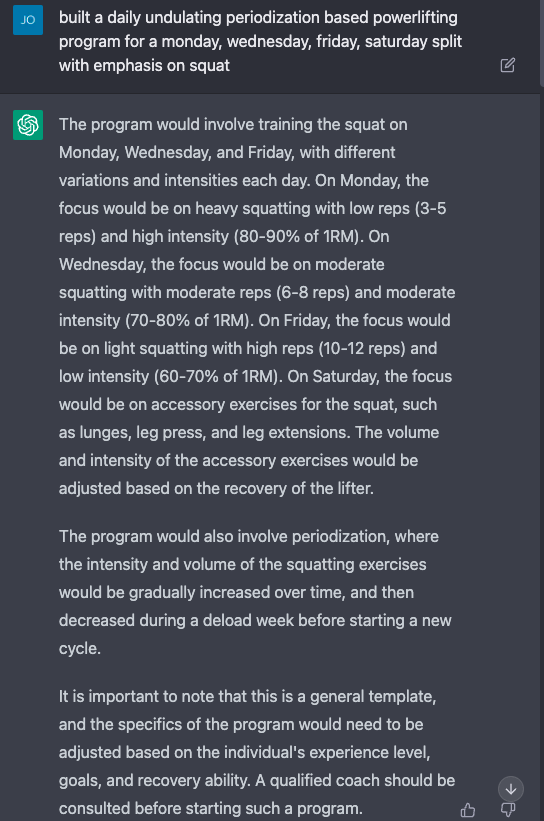
Promising so far. The plan described is daily undulating, and it even talks about progressions past the first week. The output leans descriptive, and I'm looking for something a bit more prescriptive, so I'll ask it to turn this into an actual workout program.
Prompt #2: Fix the formatting
What would that program look like?
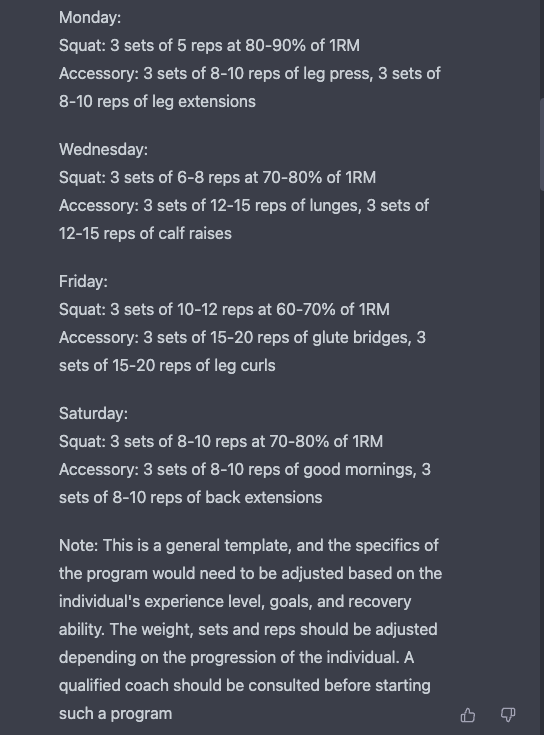
Great, now we can dig in. The first thing I notice is ChatGPT took my squat emphasis cue and ran with it. Powerlifting is a sport that includes the squat, bench, and deadlift, and bench/deadlift are nowhere to be seen. Not a problem, a novice could have caught that and fixed it in the next prompt. What's more difficult to catch are the issues with per-session volume, wide open intensity ranges (percent one rep max), and the lack of periodization on accessories. Let's put a pin in those for now and see if they improve as we further refine.
Prompt #3: Fix the obvious issues
Include bench and deadlift in the program
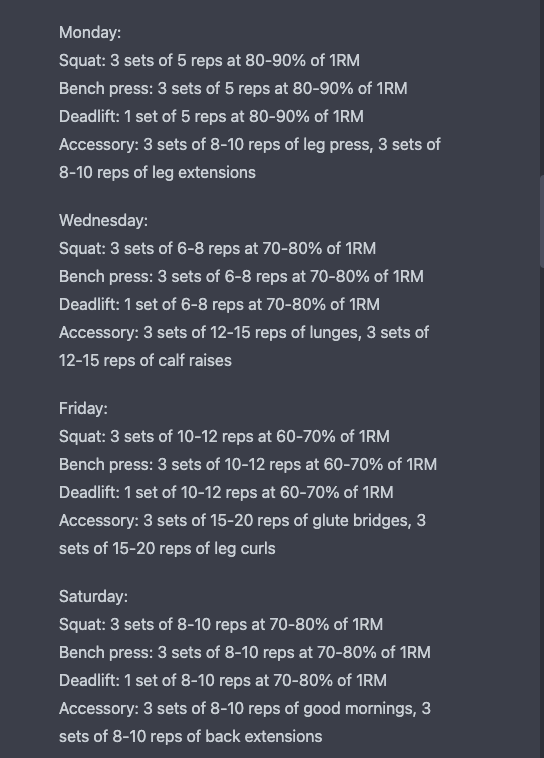
Okay, now we have a plan that might actually work. What I like about this is the volume (sets x reps) for each lift is matched on a per-session basis. That means your squat and bench volume are the same on Monday, so as long as your rest days are planned well, both your upper and lower body should be recovered for the next session. I also love that deadlift volume is significantly lower than squat and bench volume. Research shows that the body doesn't respond as well to deadlift volume as it does to squat and bench volume, and deadlift has a high fatigue impact, so reducing volume/frequency on that lift is helpful.
Although there's a lot to like, there are a few things here that are genuinely concerning.
First of all, in my 15 years of coaching I've never written a single program with 4x per week deadlift. As mentioned, deadlift has a high impact on fatigue and therefore recovery, and three of those days include intensity prescriptions of up to 80% or more. ChatGPT 'knew' about this when it wrote the plan to include fewer sets of deadlift per-session, but forgot about it when writing the frequency of the lift.
Another problem is the total volume and frequency for bench and squat. If we assume somebody reading this would take the given range as a challenge and go for maximum punishment, the prescribed volume for each of these lifts is 105 reps per week. That's what I would consider 'advanced'. In periodization there's a concept called MRV, minimum recoverable volume, and it's the minimum tonnage (interchangeable with reps per week) that elicits some sort of gain in strength. For longevity and injury risk reduction purposes, you generally always want to keep prescribed volume close to MRV. Exceptions include competitive powerlifters who are more concerned with podium placements than long term health.
Lastly, ChatGPT kept the accessories unchanged from the previous iteration of the plan. So you're getting deadlift and bench, but you're only accessorizing your squat.
The purpose of this exercise is to simulate a novice, so let's move forward assuming all is well, and see if our new trainer can extend this plan past the first week.
Prompt #4: Build me a microcycle
What would the weekly progression look like?
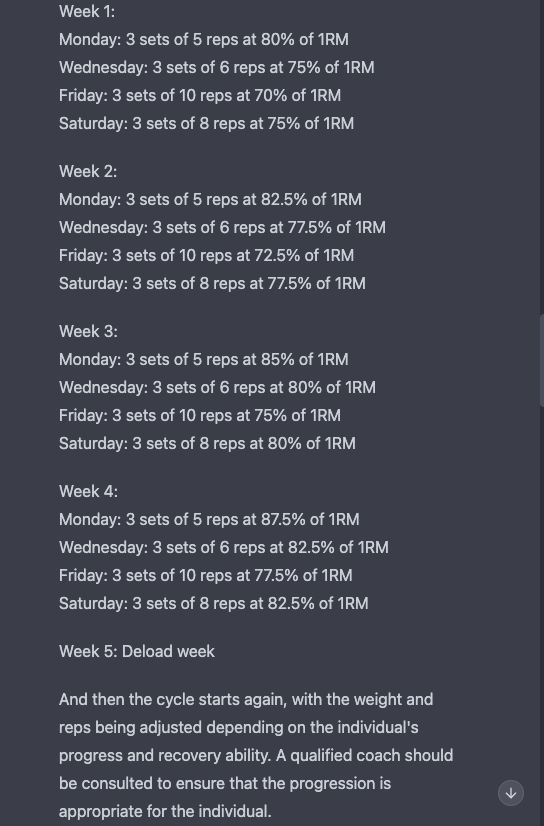
Fortunately, ChatGPT corrects the earlier issue we had with wide open rep ranges once we ask it to get specific with the weekly progression. What we get is reasonable, and because ChatGPT was smart enough to keep bench and deadlift volume matched per-session, these prescriptions work for both exercises. A 2.5% progression on a per week basis is essentially industry standard, so kudos to AI. Unfortunately we didn't get a deadlift progression, but I think it's fair to assume a novice could figure out 2.5% progression per week would apply to deadlift as well.
It was also clever enough to include a deload week in week 5. My criticism here is that I assume since there's nothing at all written besides "deload week" that we're meant to do nothing at all that week for training. That might have passed the sniff test a decade ago, but modern coaching has evolved to understand some limited movement during a deload serves to maintain technical proficiency, prevent atrophy, and allow for recovery all at the same time. No activity for a week is not ideal.
The last paragraph is informative here as well. Of course, ChatGPT admits a human trainer might be more qualified to evaluate the progress made during the mesocycle. But it wouldn't be a bad idea to test one rep max and run the same program again if progress has been made. Doing this repeatedly is one way you can evaluate MRV, which is a very powerful piece of information.
But we aren't looking to consult a human. AI is here, and who needs organic, GMO free intelligence when the artificial kind is free?
Prompt #5: Let's get macro
What would a one year macrocycle look like?
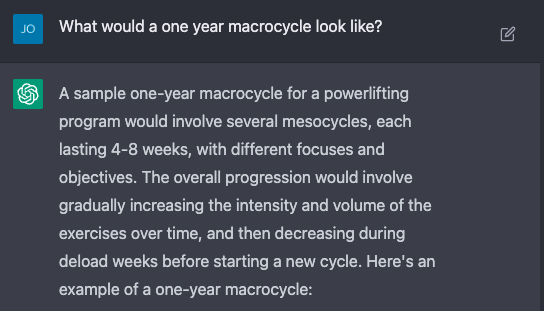
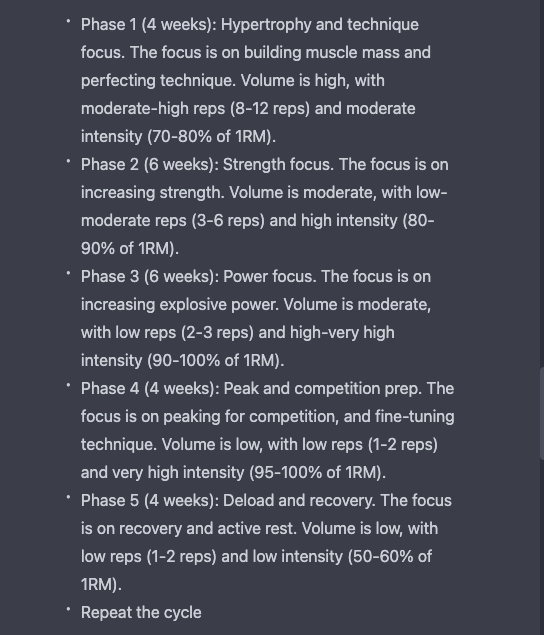
This is where the training possibilities, and potential for individualization, explode to infinity. There's a ton that can be done to make a macrocycle specific to you and your goals, and it's difficult to imagine ChatGPT managing conversational context long enough to understand everything you could tell it about your expectations and limitations for the upcoming year. With that said, there's some things to like and, as usual, to dislike about the output. Let's dive in.
The overarching concepts here are done well. Although we asked for a one-year macrocycle, we only got 24 weeks, but running something like this twice is a pretty common practice. What's fascinating is Phase 1 of this macrocycle is exactly what ChatGPT gave us, which makes me think it had a macrocycle perspective the entire time, without me prompting it. Pretty amazing.
It nailed the flow of a strength focused macrocycle. Hypertrophy, strength, power, peak, deload, repeat. It's not perfect, but it's absolutely good enough to get you going on the right long-term track.
The limitations here are as mentioned above, it has no idea what your year looks like and I'm unsure if it's even possible to integrate that information. ChatGPT has you finishing your competition prep phase 20 weeks from now, which is mighty presumptive of it. The deload and recovery phase is highly dependent on your recovery and mental state after 20 weeks of training, and I've probably prescribed a bodybuilding phase as many times as I've prescribed a deload, as a pump works miracles for healing the wounds of competition prep.
The ugly here, though is pretty telling. The hypertrophy phase as described by ChatGPT is for building muscle mass and perfecting technique. Any coach with enough trips around the block knows that the technique on the last rep of an 8-12 rep set at close to zero reps remaining is a test of will more than a refinement of technique. This phase of training is about getting your reps in without committing seppuku, technique be damned.
Similarly, the power phase is incorrectly described as increasing explosive power. Which sounds a bit counterintuitive. The sport is called powerlifting, the phase is a power phase, you're working on building explosive power. Unfortunately this is where large language models tend to falter.
Power is equal to Force times Velocity. As force or velocity increase, power increases. In strength and conditioning, a power phase might include dynamic effort work, PAP strategies, ballistic movements, etc., all in the effort of increasing rate of force development and maximum movement velocity. In powerlifting, the power phase often results in the slowest reps of the macrocycle. Although you're likely going to experience the greatest duration of exerting near-maximal force, you're very unlikely to convert that to explosive power. Improving explosive power requires explosive movement, and there's nothing explosive about crying your way through a 0.17 m/s squat double.
Does this ruin our experiment in hiring your new AI personal trainer? I think not, but it does give me pause in trusting ChatGPT's outputs of questions I've yet to ask.
We've learned a lot about ChatGPT as a program writer, but what about a coach? Let's ask it some troubleshooting questions and see what we get.
Prompt #6: I need help
When I squat, my hips shoot back at the start of the concentric phase. How do you recommend I fix this?
This is a bit of a loaded question. Sometimes the answer is not to fix this at all. Louis Simmons coached the squat like this for years (albeit for multi-ply powerlifters), but a novice can't be faulted for asking.
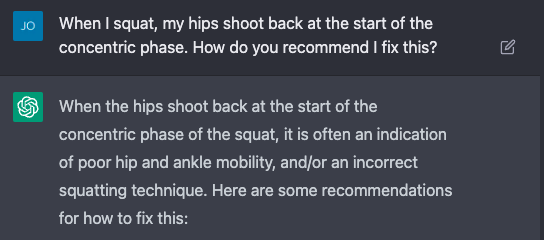
Color me triggered. Poor hip and ankle mobility is the "It's probably your alternator" of the powerlifting world. No, it's not the alternator, you left your headlights on overnight because for some reason Toyota thinks more people use their cars as flashlights for eight hours straight than forget to flip the switch off. If your positioning changes significantly at the start of the concentric, involving a significant reduction in knee flexion in favor of hip flexion, you're likely subconsciously biasing the hips over the quads, because the quads are criminally underused in day to day life and therefore much weaker than your posterior chain. Can I blame ChatGPT? I think not. This is incorrectly stated so often online that Large Language Models had no shot at getting this right. Let's carry on.
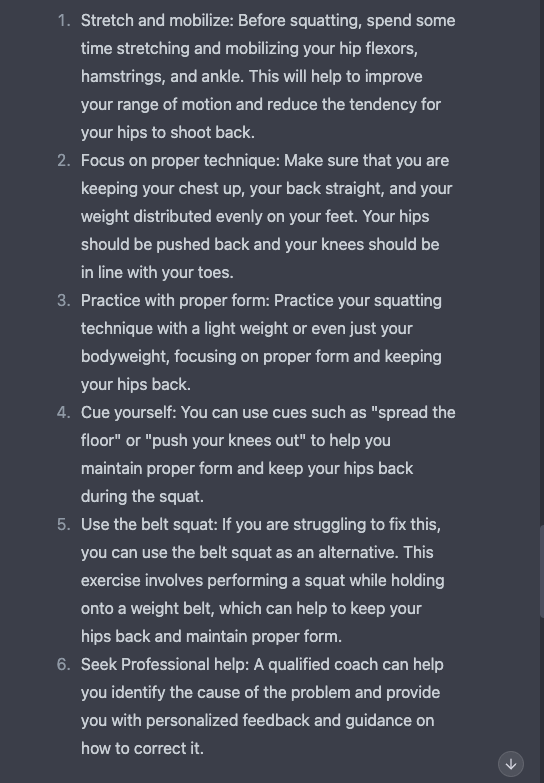
Skip to 6. Don't pass Go, don't collect $200, go to squat jail and seek professional help. While most of this advice is relatively harmless, steps one and two can cause real harm. Static stretching before athletic activity has been shown to reduce balance, reaction time, and movement time, and has been all but abandoned in favor of dynamic stretching. As for the second tip, the chest up cue is the kind of one-size-fits-all technique advice that built me a coaching business.
Technique advice, at least in this example, might turn out to be the Achilles heel of artificial smarts. Let's see what our AI coach can do for our body comp goals.
Prompt #7: Trim the fat
I'd like to go from 18% bodyfat down to about 12% bodyfat during the duration of this macrocycle, but I'd like to still gain strength. How do you recommend I change my diet to do so?
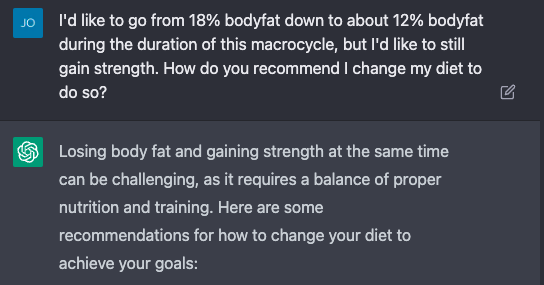
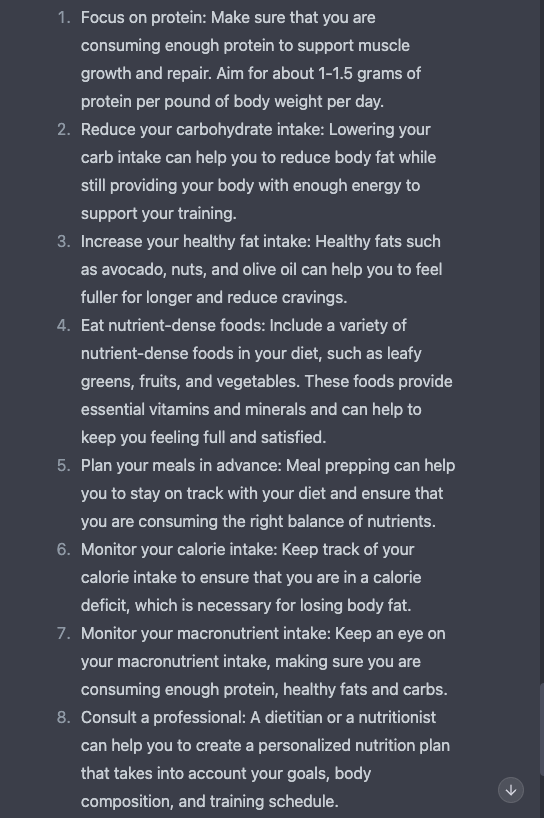
Nutritional advice is not my forte, but from what I can tell, this is decent advice. It gets to the core of the answer and describes it in detail; losing bodyfat while gaining strength requires tracking macronutrients while under a caloric deficit. Good job ChatGPT. If I were pushed to opine, I'd likely advise against dropping carbs in favor of fats as we're likely to need those carbs during training, but if my client liked fatty meats over an extra roll at dinner, I'd be inclined to defer to their preference as long as the caloric deficit and protein to bodyweight ratio remains.
Last but not least, a coach is there to help you be accountable, and to motivate you to stick to your goals. Some of the best coaches in the world are able to have an almost superhuman ability to keep their athletes and/or clients maximally engaged. What can ChatGPT do to help us grind through this four times per week deadlift program?
Prompt #8: Help me survive
I'm concerned I won't be motivated to deadlift four times per week. Can you give me some motivation?
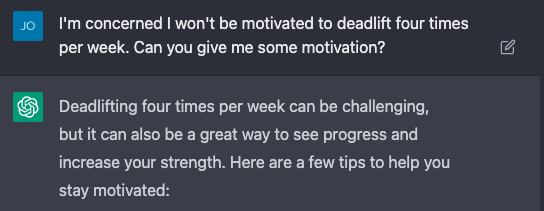
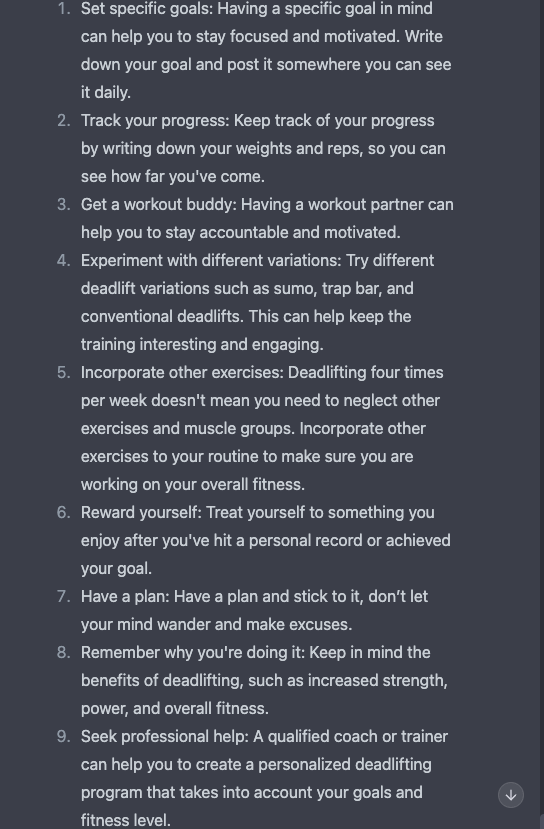
This is a list of advice I can get on board with. Goal setting is incredibly important, and although these tips don't approach the utility of something like a genuine one on one goal setting exercise, they have some of the core ingredients that make them successful. Having a clear goal, creating a good plan (check), building a reward mechanism, having a friend keep you accountable, these are all good pieces of advice for a struggling novice. Can ChatGPT give the kind of specific advice you need when you're in the deepest caverns of despair while loading a deadlift bar for the fourth time this week, only to do it again the next Monday? That remains to be seen, but the generalized advice offered here isn't a bad start.
All told, ChatGPT performed at about a sophomore level as a strength coach for novice lifters. It had a firm grasp of periodization principles, a clearly inexperienced perspective on lifting technique, and a moderate approach to motivating the client in a general sense.
As ChatGPT and other Large Language Models mature, there's a strong possibility the quality of these answers improve. What seems to be missing is a purpose-built product that can guide this intelligence in a more meaningful way. Instead of allowing the quality of the output to be dependent on the quality of the prompts, specific tools should be built like a goal setting widget, or a technique analysis widget, each with dials and controls a coach or a programmer can set that help the incredibly powerful software hone in on what the individual needs.
Our best velocity based training program yet
Learn how to incorporate velocity-based training (VBT) into your powerlifting routine. This blog post provides a simple program structure, tips for...
Learn about Velocity Based Training and how it can aid in precision within a training cycle. This guide covers what VBT is, why we use it,...